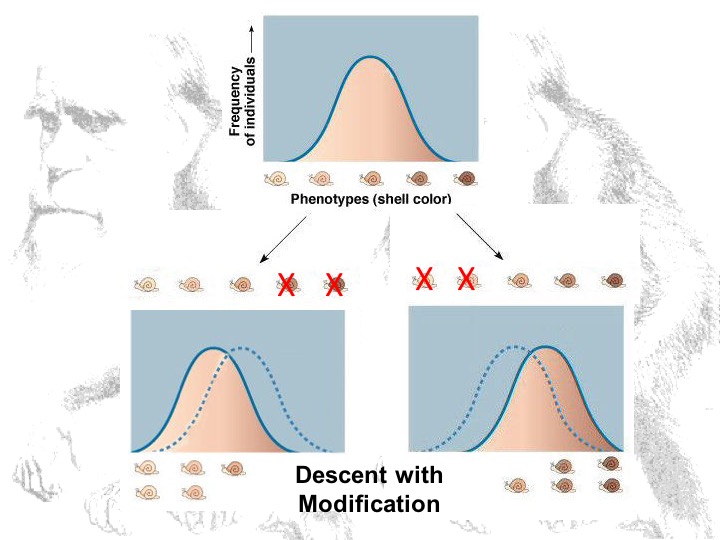 Adaptation
& Descent with Modification
as consequences of Natural Selection
Adaptation
& Descent with Modification
as consequences of Natural Selection
Consider a
species of snails that display a range of variation in shell color, from very light to very
dark. As in other snail species, shell color phenotypes are largely due to
genotype
(high heritability). Snails occur in a variety of environments,
including light sandy soils to dark forest loams. Such
environments vary over short distances (which are long distances
for snails), for example within a single backyard with different
soil types. The snail population includes both lighter and darker
snails [top].
The
degree of match between shell color and soil type confers an
advantage from avian visual predators.Suppose the single
backyard is divided by a new fence, with different environments
on either side. On lighter soils [left], light snails
are more cryptic and dark snails are preferentially eaten by birds. On darker soils
[right], the opposite is the case and darker snails are more
likely to survive.
The surviving individuals reproduce, with
population size remaining constant. Each population now shows
better adaptation [is better adapted]
to its local environment. The character distribution of its
members is such that they are are on average more likely to survive and
reproduce than those in the preceding generation. Because
offspring resemble their parents, the next generation will have a
different character distribution than the preceding. Descent with
modification will occur, such that each population has
greater fitness [is
more fit]. The populations will diverge from each other: if
continued indefinitely, the populations may over time evolve into
distinct species.
NB: Language can introduce
ambiguity in this model. English uses a Subject-Verb-Object
(SVO) structure, which implies three separate components,
things that act on other things. Asked to
describe what we see in a meadow, a Mammalogy class might say, "I
see deer eating grass," or recognize it as a single process,
"grazing". In the present example, during the process of adaptation
[noun], a population adapts [verb] and becomes better
adapted [adjective], by means of new adaptations [noun']
in darker and lighter shell colors. We could go so far as to say,
"Adaptation adapts adaptations," or call this an "adaptive
process."
HOMEWORK: Standing
in the same meadow, what might a plant ecology class
see? Is it the same or different from what the mammalogist sees?

